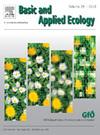Effects of plant functional group removal on caterpillars (Gynaephora alpherakii) performance and plant production in an alpine meadow
IF 3.5
2区 环境科学与生态学
Q2 ECOLOGY
引用次数: 0
Abstract
Loss of plant functional group diversity has significant repercussions for ecosystem productivity globally. However, our understanding of how this loss of specific functional groups, particularly those providing non-food resources, influences herbivores and, consequently, ecosystem productivity remains limited. To elucidate these, we conducted a series of experiments consisting of (1) a two-factor field experiment, where we manipulated the forb abundance and caterpillar presence to assess their interactive effects on plant productivity and caterpillar performance, (2) a field complementary shelter addition experiment, designed to isolate and evaluate the effects of microclimatic changes resulting from forb removal, and (3) a confirmatory microcosm experiment to validate the field findings under controlled by monitoring the herbivory patterns. Our results show that forb removal significantly decreased the aboveground plant biomass (APB) by 41.3 %, but did not affect the APB of sedges. The presence of caterpillars significantly decreased total APB by 16.7 % and APB of sedges by 34.8 %, but these effects disappeared with forbs removed. Specifically, forb removal significantly increased caterpillar mortality rates by 319 % and decreased caterpillar body size by 27.2 %, which in turn diminished the herbivory pressure on sedges. Changes in caterpillar performance were correlated with maximum and average soil surface temperatures influenced by forb removal and the addition of shelters. Further investigation by the confirmatory microcosm experiment indicated that the absence of forbs decreased the feeding time of caterpillars and deprived caterpillars of refuge from the midday heat and intense sunlight, ultimately resulting in lower body size and higher larval mortality. Our findings suggest that forb removal disrupts trophic interactions, with potential cascading effects on herbivore populations, plant community structure, and ecosystem productivity. These results underscore the importance of plant functional diversity in maintaining ecosystem stability, especially under changing environmental conditions.
去除植物官能团对高寒草甸毛虫生产性能和植物产量的影响
植物功能群多样性的丧失对全球生态系统生产力产生重大影响。然而,我们对这种特定功能群的丧失,特别是那些提供非食物资源的功能群,如何影响食草动物,从而影响生态系统生产力的理解仍然有限。为了阐明这些,我们进行了一系列的实验,包括:(1)一个双因素的田间实验,在那里我们控制了牧草丰度和毛虫的存在,以评估它们对植物生产力和毛虫性能的相互作用;(2)一个田间补充遮蔽物添加实验,旨在分离和评估由牧草去除引起的小气候变化的影响。(3)通过监测草食模式控制下的验证性微观实验,验证田间调查结果。结果表明:除草可显著降低地上植物生物量(APB) 41.3%,但对莎草的APB没有影响。毛虫的存在使总APB降低16.7%,使莎草的APB降低34.8%,但去除杂草后,这些影响消失。其中,除草可显著提高虫草死亡率319%,降低虫草体型27.2%,从而减轻了对莎草的食草压力。虫草去除和添加遮蔽物对土壤表面最高温度和平均温度的影响与冬虫夏草产量的变化有关。进一步的确证性微观实验表明,草叶的缺失减少了毛虫的取食时间,使毛虫无法躲避正午的高温和强烈的阳光,最终导致幼虫体型变小,死亡率升高。我们的研究结果表明,清除牧草会破坏营养相互作用,对食草动物种群、植物群落结构和生态系统生产力产生潜在的级联效应。这些结果强调了植物功能多样性在维持生态系统稳定中的重要性,特别是在不断变化的环境条件下。
本文章由计算机程序翻译,如有差异,请以英文原文为准。
求助全文
约1分钟内获得全文
求助全文
来源期刊

Basic and Applied Ecology
环境科学-生态学
CiteScore
6.90
自引率
5.30%
发文量
103
审稿时长
10.6 weeks
期刊介绍:
Basic and Applied Ecology provides a forum in which significant advances and ideas can be rapidly communicated to a wide audience. Basic and Applied Ecology publishes original contributions, perspectives and reviews from all areas of basic and applied ecology. Ecologists from all countries are invited to publish ecological research of international interest in its pages. There is no bias with regard to taxon or geographical area.
 求助内容:
求助内容: 应助结果提醒方式:
应助结果提醒方式:


